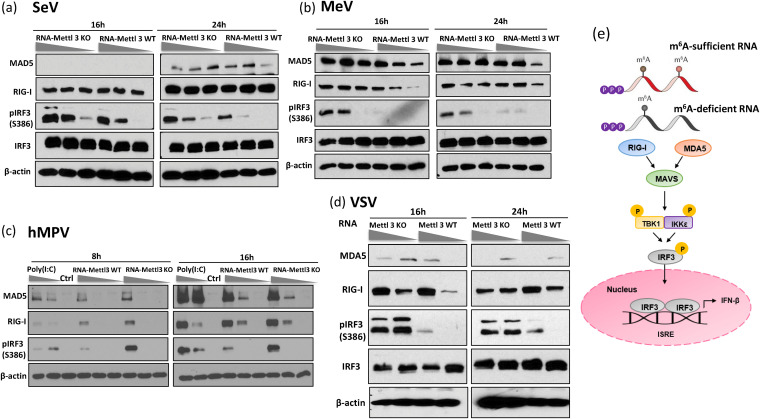FIG 6.
m6A-deficient viral RNA enhances expression of molecules involved in type I IFN signaling pathway. (a to c), m6A-deficient virion RNA increases expression of RIG-I and MDA5 and induces higher IRF3 phosphorylation. A549 cells were transfected with virion RNA of SeV (a, at doses of 2 × 105, 1 × 105, and 5 × 104 RNA copies), MeV (b, at doses of 1 × 106, 5 × 105, and 2 × 105 RNA copies), and hMPV (c, at doses of 107, 106, and 105 RNA copies) grown on METTL3 KO or WT U2OS cells. (d) m6A-deficient total RNA from VSV-infected cells increases expression of RIG-I and MDA5 and induces higher IRF3 phosphorylation. A549 cells were transfected with total RNA from VSV-infected cells at doses of 1 × 108 and 1 × 107 RNA copies grown on METTL3 KO or WT U2OS cells. At indicated times, cell lysates were analyzed by Western blotting using antibodies specific to RIG-I, MDA5, IRF3, IRF3 phosphorylated at S386, or β-actin. Western blots are representative of n = 3 biologically independent experiments. (e) A cartoon model for type I IFN signaling pathway. m6A-sufficient or -deficient viral RNA is detected by either RIG-I or MDA5, engaging the adaptor protein MAVS, which leads to the phosphorylation of IRF‐3 by TBK1/inducible IκB kinase (IKK‐i), the formation of IRF‐3 homodimers and/or heterodimers, and translocation into the nucleus, resulting in the expression of type I IFNs.

